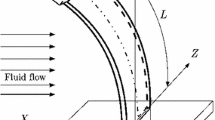Abstract
It is shown that the excitation of vibration by the artificial introduction of delayed terms may have certain advantages in vibration testing or fatigue testing. As illustration, in the simple mechanical system studied, the amplitude and frequency of vibration were relatively unaltered by large changes in damping. With varying delay time, large changes were produced in the frequency of vibration. Analytical predictions agree with experimental results and confirm the observation that an increase in the magnitude of the delayed term, beyond a certain limit, leads to unstable behavior.
Similar content being viewed by others
Abbreviations
- C1, C2, C3 :
-
constants
- F :
-
force applied to shake table (lb)
- L :
-
unit of length (=0.431 in.)
- M :
-
mass of table and attachments (lb sec2 in.−1)
- P :
-
static load to deflect beam (lb)
- a :
-
maximum value of dimensionless variablex
- b, c :
-
constants
- k 1 :
-
spring constant, lb in.−1
- k 2 :
-
spring constant, lb in.−3
- m :
-
mass of accelerometer and attachments (lb sec2 in.−1)
- t :
-
time (sec)
- x :
-
dimensionless displacement=z 1/L
- z 1,z 2 :
-
displacements of massesm andM (in.)
- α:
-
dimensionless parameter (=b/M)
- δ:
-
central deflection of beam (in.)
- ϕ:
-
phase angle (radians)
- τ:
-
time delay (sec)
- ω:
-
angular velocity (radians/sec)
References
Mitereff, S. D., “Principles Underlying the Rational Solutions of Automatic Control Problem,” Trans. ASME, 57–159 (1935).
Callender, H. P., “Time Lag in a Control System,”Phil. Trans. Roy. Soc., 235 A, 415 (1936).
Teichmann, T., “Closed Loop Control Systems Containing a Digital Computer,” Trans. IRE, Ec-4 (3),September 1955.
Kato, S., “Theoretical Research on Chatter Vibration of Lathe Tools,” Memoirs of the Faculty of Engineering, Nagoya University,10 (2),November 1958.
Wallis, G. B. and Heasley, J. H., “Oscillations in Two-Phase Flow System,” Trans. ASME, 60-WA 209, December 1960.
Cracco, L., Grey, J., and Harrije, D. T., “On the Importance of the Sensitive Time Lag in Longitudinal High-Frequency Rocket Combustion Instability,” Jet Propulsion,28 (841),December 1958.
Felgar, R. P., “Development of an Apparatus for Fatigue Testing in a Vaccum,”Experimental Mechanics,3 (11),269–274 (1963).
Kryloff, N. and Bololiuboff, N., “Introduction to Non-Linear Mechanics,” Princeton University Press, 1943.
Minorsky, N., “Non-Linear Mechanics,” L. W. Edwards, Ann Arbor, Mich., 1947.
Author information
Authors and Affiliations
Rights and permissions
About this article
Cite this article
Finnie, I., Lim, B.Y. A simple model to illustrate some aspects of vibration excitation by delayed terms. Experimental Mechanics 4, 352–355 (1964). https://doi.org/10.1007/BF02322793
Issue Date:
DOI: https://doi.org/10.1007/BF02322793




